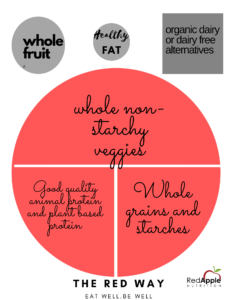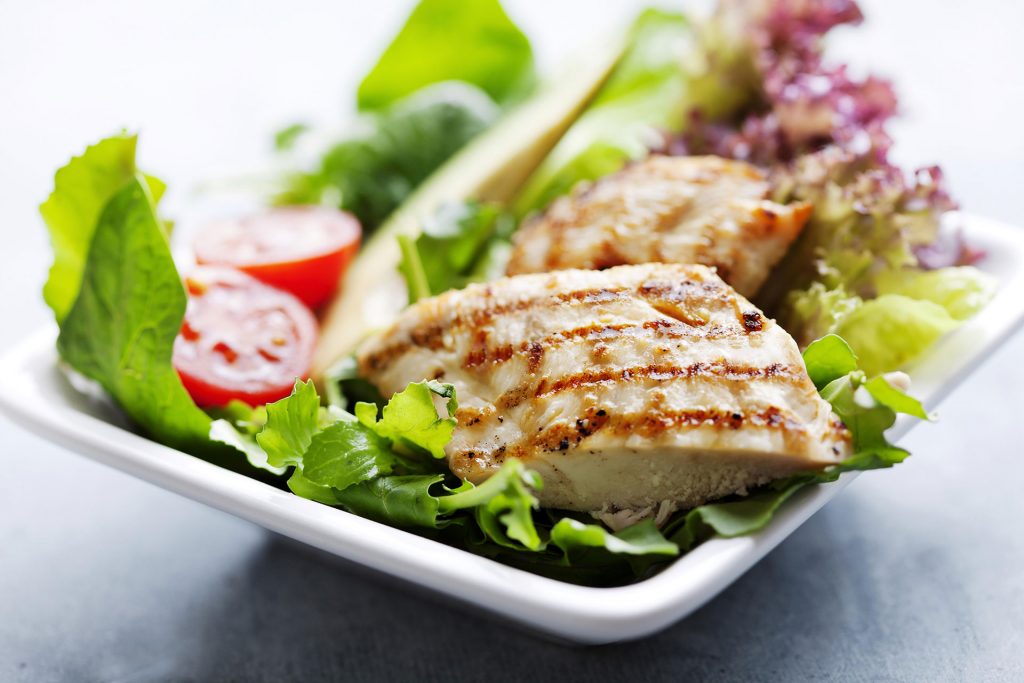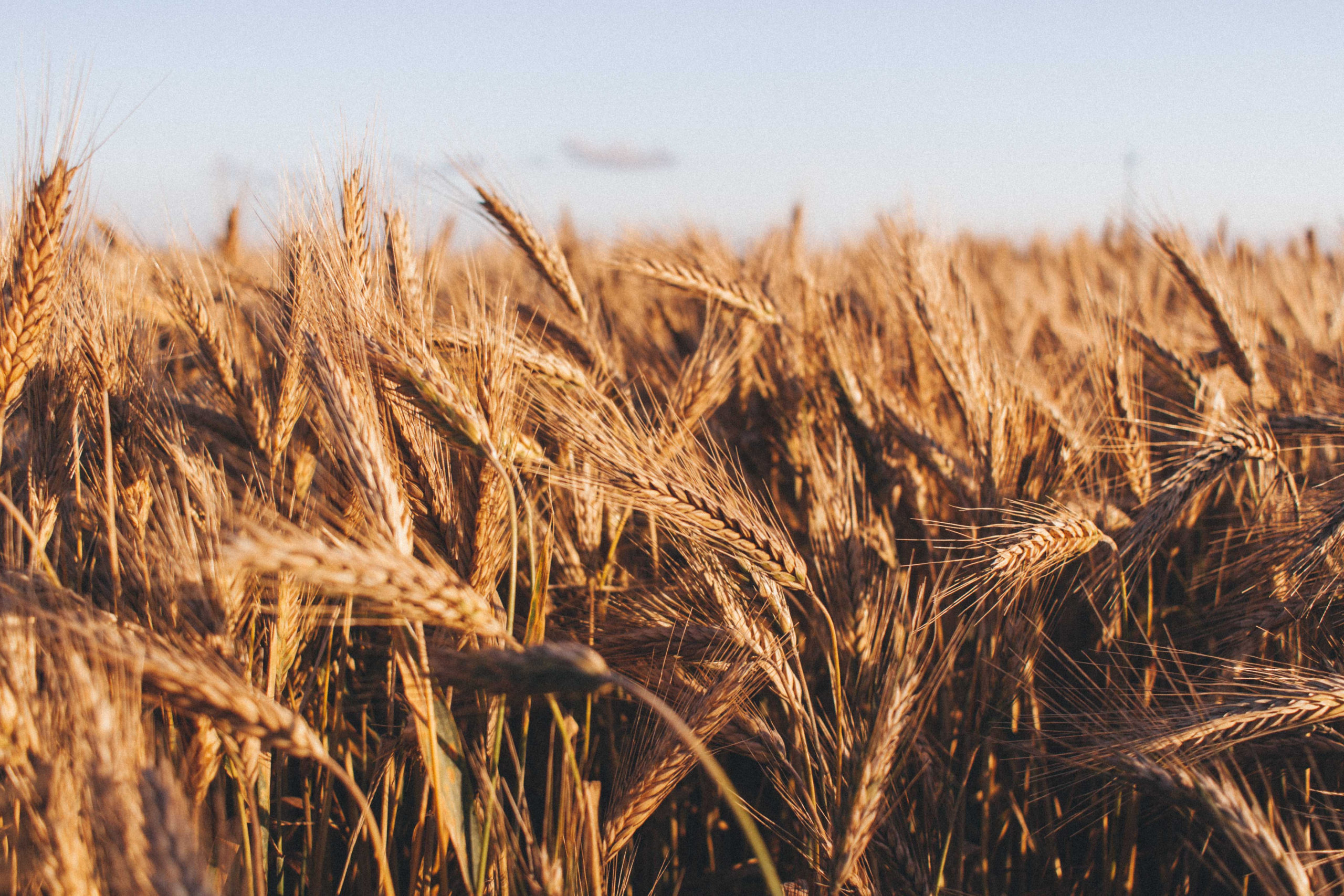Over the past several decades, Americans have slowly and steadily begun to rely on meals away from home and convenience foods. With more women working than ever (hands up to that!), business travel and increased kid activities, it is no wonder why we have begun to rely on more convenient ways of eating. Unfortunately, meals away from home tend to contain less vegetables, fruit, whole grains and fiber and tend to have more calories from processed fats, sugar and sodium.
Today, eating out has come to a pretty hard halt. With rising cases of COVID-19, the world has been forced to prepare more meals at home. This guide will help you to understand the importance of meal planning, shopping that will help you stay sane and ideas on what to include in your meal plan.
Why Meal Plan?
- Ensures proper balance
- Assures variety and prevents boredom
- Saves money
- Saves time
- Avoids asking the question “What’s for Dinner?”
Shopping Made Sane
- Plan meals in advance: Set aside time each week to create meal plans using themes to help stick to a plan every week such as “Meatless Monday” and Taco Tuesday”
- Look for sales and seasonal items: Shopping at local farm markets is a great way to save and each fresh produce. CSA (Community Supported Agriculture) is a great way to buy into a farm with out actually being the farmer. You can pay each week to pick up a box full of fresh produce picked that week from local farmers
- Shop from a list and stick to it: Everyone knows that if you stick to the list, not only does it prevent check out add ins, but it also helps the pocket book! Here is a great guide to help with shopping
- Select foods that have varying preparation time, cooking requirements and cooking skills: This will help ensure that you are not wasting any food and can use up everything you have.
- Stick to the perimeter: Most of the foods we choose on the perimeter of the store as a short shelf life, meaning it will spoil! The closer you get to the center isles, the more processed and the more preservatives are added to prolong shelf-life.
- Don’t go to the store hungry: This may cause unwanted items coming into the home!
Meal Planning Tips
Experiment with various styles of cooking and preparation
- Stir-fry: quick and allows you to enjoy a meal in 5-10 min
- Braising and roasting: allow you to do other tasks while these foods cook
- Pizzas: can be very healthy if made in the home. You can control what goes on the pizza and how much. Load it up with veggies
- Grilling: Can be very quick and allows excess fat to drip away from the food
- Try cooking with an instapot! You can have meals in literally minutes. If you are short on time and need to throw something together quick, this is a great investment. Some great options are soups, roasts and grain dishes. Dried Beans can be ready in 30-35 minutes without having to soak them! Grab a few recipes here.
No cook and reheat options are always great: leftovers!
- Make a quick sandwich or salad with leftover chicken, turkey, beef or fish
- Supplement with various dressings and condiments like hummus, avocado slices or vinegar.
- Use leftover salmon to make salmon patties
- Leftover meatloaf to make a sandwich
- Mix leftovers with eggs and make a frittata
- Quesadillas, tacos or burritos are great to use up leftovers!
- Make a soup! This is a wonderful way to use up produce
Learn to make it healthier with cooking substitutions
- Use fruit, fruit juice and citrus zest to sweeten your food
- Add flax meal, chia seeds, hemp seeds and wheat germ to batters to boost fiber
- Use unsweetened applesauce, yogurt, or pumpkin puree in place of oil
- Use tofu to replace milk by blending silken tofu with water until it has the consistency of milk
- Experiment with teff, quinoa, amaranth, oat and garbanzo bean flours.
- Use oil, grass-fed butter or ghee in place of margarine
- Decrease sugar in baking by one-fourth or try using monk fruit!
- Use Plain Greek yogurt in place of sour cream and mayonnaise or try smashed avocado for recipes like this one
- Experiment with various oils for cooking and baking like olive oil, sesame oil, coconut oil and avocado oil
Experiment with herbs and spices
- Basil: has a spicy aroma and flavor of pepper, clove, mint and licorice. Very little needed for flavor. Add to finish a dish or add to sauces, pesto, potatoes, salads and rice dishes. Benefits: Antimicrobial, powerful adaptogen, antioxidant
- Mint: is very hardy and fragrant. Best used fresh in soups, stews, stuffing and salads. Delicious with carrots, potatoes, eggplant, beans, grilled fish and lamb. Benefits: aids digestion, palate cleanser
- Thyme: Essential in Western and Middle Eastern cooking. It is very earthy with a taste of clove and mint. Is very tasty fresh or dried. Wonderful in slow cooked recipes like stews and slow cooked meals. Combines well with garlic, onion, red wine, basil, lavender and parsley. Use in tomato and wine based sauces, soups, marinades for pork and poultry as well as mushrooms, leeks and eggplant. Benefits: anti-bacterial, fights sore throat, digestive health, anti-diarrheal, boosts immune system
- Parsley: Found either curly or flat, parsley is fresh and spicy with a hint of pepper. Stems are even more flavorful than the leaves. Great for broths and stocks, salads, tabbouleh, fish and omelets. Benefits: aids digestion, decrease bloating, boost immunity, detox and kidney health
- Cilantro: Earthy with a parsley, mint and lemon characteristic. Pairs well with almost any savory food or light and fresh cuisine. Great in chutneys and salsas. Pairs well with fish, seafood, beans, plantains, root vegetables and squash. It is best to add fresh at the end of cooking. Benefits: detox-helps rid body of toxic metals, aids digestion, helps with sleep
- Rosemary: Smells and tastes like lavender and nutmeg. Combines well with thyme, bay leaves, garlic and wine. Best when used fresh. Pairs well with pork, lamb, poultry, zucchini, potatoes and tomatoes. Benefits: boost memory, decrease inflammation, healthy skin, fights bacterial infections
- Sage: is referred to as the herb of longevity. Has a pleasantly pungent lemony flavor and makes a great addition to soups, breads, stuffing, sauces and pasta dishes. Part of the mint family and is great fresh or dried. Benefits: aids digestion, helps decrease heartburn
- Ginger: A spicy, fragrant spice used in many ways. As a delicacy, medicinally or as a spice. Is a quintessential ingredient in Asian cooking, but also can be used in baking. Pairs well with stir-fry, marinades, vegetables and dressings. Benefits: aids digestion, decrease inflammation and nausea
*For more info on herbs check out Herbal Living
Experiment with various grains instead of sticking to the same old boring starches
- Quinoa: red, white, black or tri-color variations. Nutty profile. High quality protein and gluten free. Light, tasty and easy to digest.
- Bulgur: a whole grain that has been cracked and partially cooked. Is high in fiber and used in Middle Eastern cuisine. Is not gluten free but can be substituted for rice, quinoa, barley or couscous.
- Barley: high in fiber and in protein. Has a chewy and nutty flavor like rice. Most often found in soups but can be excellent as a substitute to many other grains in dishes such as stir-fry, curries or risottos.
- Teff: The smallest grain in the world. Has a mild, nutty flavor and is high in calcium, protein and fiber. A great addition to stews, pilafs and baked goods. Also great as a breakfast cereal. Is naturally gluten free.
- Couscous: Light and fluffy grain that is used in North African cuisine. Usually served with meat or vegetables. Traditionally made from cornmeal, but today from semolina. Semolina is sprinkled with water then rolled with hands to form the small pellets, then sprinkled with dry semolina to prevent from sticking.
- Millet: Tiny and round in shape, can be white, red, yellow or gray. Has a mildly sweet and nutty flavor. Can be made creamy like potatoes or fluffy like rice. Delicious and can accompany many dishes. High in iron, B vitamins, copper and magnesium. Is easy to digest and gluten free.
- Amaranth: A high quality source of protein. Is packed with iron, calcium and fiber. It is very easy to digest and is gluten free. Can be cooked like popcorn or made into a porridge-like consistency or pilaf.
- Buckwheat: a cereal grain that is actually a fruit seed related to rhubarb. Sold as a flour, kasha (toasted buckwheat groats) or groats (hulled whole buckwheat) Is naturally gluten free. Excellent addition to soups, pancakes, or cereals.
- Farro: Looks like barley, tastes like barley and cooks like barley. It is a bit chewier than barley. High in iron and fiber. Great addition to side dishes and salads.
Building Your Menu
Breakfast ideas
- Whole grain toast with natural nut butter and banana
- Avocado Toast. Add sliced tomatoes or radishes, fresh greens and a dash of everything but the bagel seasoning or herb of choice. For Avocado, can just slice and add to toast, or can smash in a bowl with dash of garlic powder, cumin and lemon juice.
- Plain yogurt with dash of vanilla, granola, nuts and berries
- Oatmeal with berries and walnuts and a dash of milk or try overnight oats
- Breakfast muffin made with eggs and veggies
- Whole grain cereal with milk, fruit and nuts. For a homemade cereal blend try this Quinoa Crunch Granola!
Lunch Ideas
- Whole grain pita or Spring Roll Wrapper with hummus, veggies, dash of oregano and feta
- Spinach salad with leftover chicken, fresh raspberries, slivered almonds and balsamic vinaigrette
- Chicken salad with diced apple or pear, red grapes and chopped pecans. Add plain yogurt and enjoy on a bed of lettuce or whole grain bread
- Couscous or quinoa with tomatoes and cucumbers, fresh basil, pine nuts and a sprinkle of parmesan cheese
- Try tuna with smashed avocado, lemon juice, onion and celery. Serve in a tomato, over a salad or on whole grain toast.
Dinner Ideas
- Pita Pizzas with tomato sauce or fresh tomato slices, basil/oregano and veggies
- Chicken sausages (we like Amylu Foods!) with onion, spinach and fresh tomatoes topped over whole wheat pasta, rice or quinoa
- Bulgur salad topped with pork tenderloin. Season bulgur with cilantro, lemon juice, olive oil, salt and pepper
- Slow cooked barbecued turkey sandwiches. Add turkey and barbecue sauce with celery and onion in a crock pot or InstaPot. Serve with whole wheat buns and top with chopped cabbage for a crunch.
- Veggie Tacos with black beans, onions, salsa and avocado. Heat a can of black beans in a small pot with onions and a dash of cinnamon. Cook for about 8 minutes and serve with salsa, avocado on a tortilla of choice!
- Open faced grilled cheese on whole grain toast with fresh mozzarella, sliced tomato and fresh basil. Serve with large green salad
- Try these delicious and easy Pumpkin Enchiladas!
Focus on Balance
Understanding balance is key. Ensure that each meal includes a protein, fat and carbohydrate. Plate Planning is an excellent tool to help ensure that you are getting balance on your plate. Below is a crash course on understanding the macros:
Protein: Without protein, life would not exist. Protein is found in many tissues of the body such as muscle, skin, and bone and is used for growth, maintenance and repair. It is important to eat enough protein to maintain healthy functioning. Amino acids, the building blocks of Protein are essential to life and are responsible for neurotransmitter activity. Neurotransmitters steer every emotion.
- Animal–Meat, Fish, Poultry, Dairy
- Plant-Nuts, Beans, Seeds, non-GMO Soy, Nut butters (choose natural nut butters with very little added (salt and nuts only))
Fat: Sixty percent of the brain is fat, which makes it important to include fat on a daily basis. We also needs fats to absorb fat soluble vitamins, K, D, E and A. In addition, fat adds satiety to our meals. Ounce for ounce, fat contains more calories than any other nutrient. Quality of fat is the most important when choosing which fat to consume. Include fats primarily found in plant-based foods. Avoid trans fat and be mindful of the quality of animal fat…we are what they eat! Choose grass-fed, organic meats when possible.
- Good quality saturated Fat-grass-fed beef, organic chicken and eggs, organic whole dairy products, grass-fed butter and ghee, wild game, coconut oil
- Unsaturated Fat-nuts, seeds, natural nut butters, avocados, fatty fish (salmon, tuna, herring, mackerel), extra virgin olive oil
- Trans Fat-stick margarine, commercially baked goods, snack foods (avoid hydrogenated oils)
Carbohydrates: Carbohydrates are a source of energy and are essential for cellular health. Without carbohydrates, our bodies cannot function properly. It is important to include carbohydrates for a balanced diet. Choose whole unrefined grains/whole starches for fiber and overall health! Avoid added refined sugar and sweets regularly. Sources of carbohydrates include:
Bread, cereal, pasta, rice, quinoa, barley, bulgur, millet, buckwheat, beans, starchy vegetables–potatoes, corn, peas, lima beans—fruit, milk, yogurt, vegetables, sugar, sweets, honey and maple syrup (avoid too many sugars and sweets)
- Refined: processed, white grains, more ingredients added. (avoid enriched grains)
- Unrefined: Whole, unprocessed, as nature intended, higher in fiber, protein and vitamins/minerals (choose whole grains)
For a more in depth understanding of balance, we offer a Back to Basics Course specifically designed to provide a thorough understanding of balance and also provide accountability and access to recipes to ensure proper balance and help with reaching your health goals. For more information, click here.
Putting Into Practice
Once you understand balance, it is easier to plan your menu. A great tool to use is the plate method or this modified version-The Red Way! This will help you visualize what your plate should look like with each meal. You do not always have to include a dairy or a fruit, but the idea is that you include a balance of carbs, fats and protein. If adding a fruit, you can always opt out of a grain or starch since the fruit is considered a carbohydrate.

For a more in depth understanding of balance, we offer a Back to Basics Course specifically designed to provide a thorough understanding of balance and also provide accountability and access to recipes to ensure proper balance and help with reaching your health goals. For more information, click here.
We are here to help you with all your nutrition needs. If you need more assistance with planning, let us help you! Contact us today to get started!



